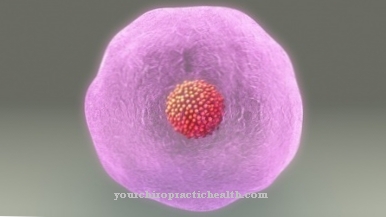Priming is an effect of neuroanatomy and is also called Facilitating designated. A stimulus that was received earlier is processed more effectively by the nervous system when it occurs repeatedly. Degenerative brain diseases make priming difficult.
What is priming?

If a certain stimulus has already been processed in the past, repeated processing will bring it to cognition more quickly or more effectively. Psychology and neurophysiology know this phenomenon under the term priming. Priming is often referred to as "relearning" based on these relationships. The cortical areas of the brain are predominantly involved in priming processes.
In a larger context, priming is also referred to as facilitating. Pathways describe the repeated excitation of certain nerve tracts, which can increase the efficiency of equally strong stimuli or make the affected pathways accessible to weaker stimuli. In this context, priming is a process of long-term potentiation and thus sometimes makes up the learning effect of human nerve cells.
In addition, priming plays a role in selective perception. This term is used to describe a psychological phenomenon that makes people in the same situation more likely to perceive different stimuli and hardly perceive different of the predominant stimuli. Selective perception can be based on priming effects.
Function & task
Priming is a learning process that directly affects the nerves and neural pathways. In this context, a distinction is made between temporal and spatial orientation. In the case of spatial facilitation, a synapse is stimulated in the area of several spatially different afferents. In the case of temporal facilitation, different individual stimuli arrive in rapid succession at the same afference of a specific synapse. The totality of these stimuli evokes a postsynaptically exciting potential after they have subsided. Every time there is a pathway, there is a depolarization of the nerve cell.
Based on this originally neurophysiological concept of priming, the term has expanded and extended to the consideration of phenomena in brain research, psychophysics, behavioral physiology and social psychology. The original understanding of the term from neuroanatomy primarily relates priming to long-term potentiation. This temporal orientation corresponds to the learning effects of nerve cells, which inevitably must be preceded by an earlier spatial orientation that takes place at several afferents.
In psychology, priming is tied to stimuli. A stimulus is able to influence the processing of a subsequent stimulus. This influence can be positive or negative and is related to which memory contents are activated by the stimulus. This type of priming corresponds to an associative activation, which is relevant as a so-called context effect. In a dialogue, the answer to a certain question can, for example, have an impact on the following questions. For example, if the first question activates negative ratings, all subsequent questions are negatively associated. In a similar way, priming is relevant to selective cognition.
The learning theory associates somewhat different content with the term. Learning theorists assume that the frequent repetition of certain information facilitates this memory content. Each piece of information corresponds to a neural correlate of the mental representations. The more often certain information is practiced with the simultaneous activation of other representations, the more likely the individual representations will be permanently linked to one another. In this way, associations with certain terms arise. For learning theory, facilitating effects are the neurophysiological precursors of thoughts and memories. In this context, priming is partly responsible for ensuring that incomplete words or images can be completed by the individual.
You can find your medication here
➔ Medicines against memory disorders and forgetfulnessIllnesses & ailments
The priming effect plays a role in connection with certain diseases. For example, patients with Parkinson's disease often receive L-dopa supplements in the early stages of the disease. These preparations suppress the characteristic tremor caused by the disease for a few hours. The drugs cross the blood-brain barrier and act directly on the brain. Some side effects are associated with long-term use of the medication. This is especially true for dyskinesia. Medicine understands this to mean movement disorders, especially those of the limbs.
A common side effect, for example, is the involuntary wave movement of the limbs. In most cases, these dyskinesias only appear after several years of use and subside as soon as the drug is discontinued. However, if the patient returns to L-Dopa after a long break, dyskinesias that have occurred in the past will reappear immediately. If the medication is taken repeatedly, the recurrence no longer takes several years, but occurs without delay. Science has meanwhile linked this connection with the priming effect.
Apart from these relationships, degenerative diseases of the brain in particular can make priming difficult and thus impair the ability of nerve cells to learn. This is especially true for brain diseases in which the cortical areas of the brain are damaged. For example, one sign of impaired priming due to cortical lesions is an inability to complete words. Especially neurological diseases with effects on the area of long-term potentiation are a current subject of research in medicine.
In addition to Alzheimer's, Crohn's disease also has an impact on long-term potentiation. Due to the breakdown of neuronal synapses, priming is no longer possible and dark areas arise in the memory of those affected. Psychological priming can also be disrupted by various processes and cause diseases. For a person with a predominantly negative view of the world, priming activates negative associations within any situation and conversation, for example, and in this way leads to the person concerned developing more negative memories over the long term.



























